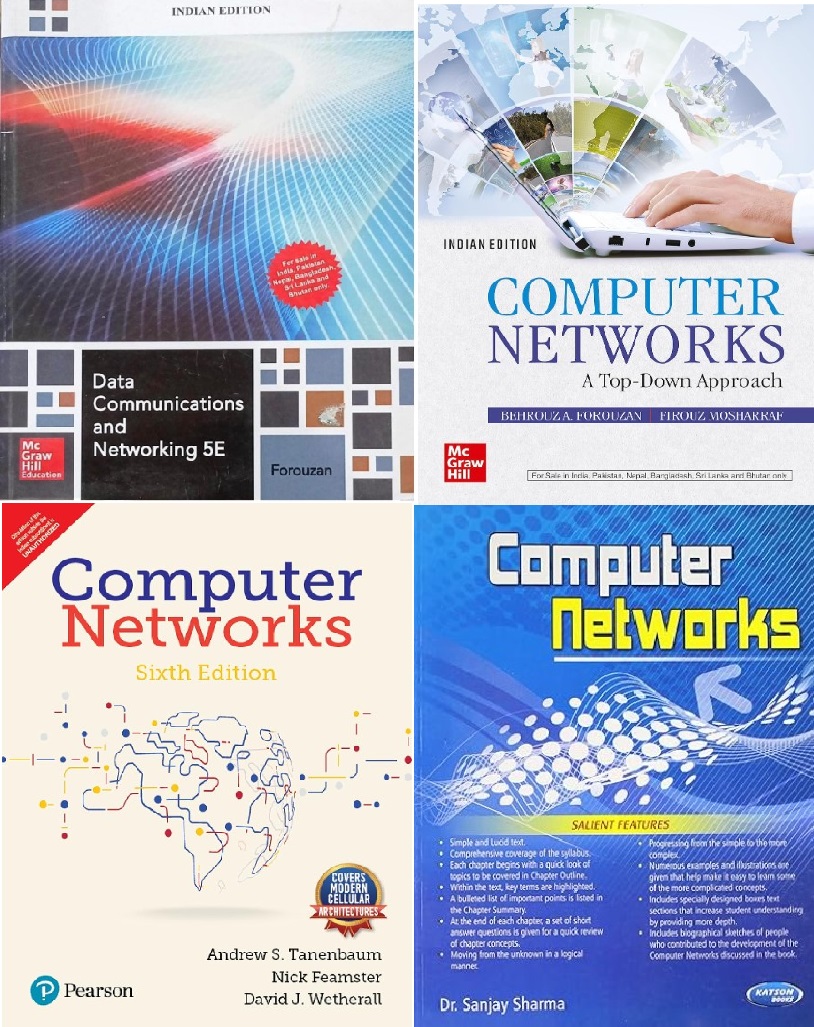UNIT 2: Physical Layer
Physical Layer: Transmission media, Signal transmission and encoding, Network performance and transmission impairments, Switching techniques and multiplexing, Overview of PSTN, ISDN, and ATM
Q1 – The physical layer is concerned with the transmission of _______ over the physical medium.
Datagrams
Packets
Frames
Bits
Ans – (4)
Explanation – The physical layer is concerned with the transmission of bits over the physical medium. It deals with the actual transmission of raw binary data (0s and 1s) without any formatting or structure.
Q2 – The…………. layer change bits onto electromagnetic signals.
Physical
Transport
Data Link
Presentation
Ans – (1)
Explanation –
The Physical layer changes bits into electromagnetic signals.
The Physical layer is responsible for transmitting raw data bits over a physical medium, such as copper wires, optical fibers, or wireless frequencies. It deals with the actual physical connection and transmission of data between devices.
Q3 – Before data can be transmitted, they must be transformed to __________.
Periodic signal
Electromagnetic signals
Aperiodic signals
Low-frequency sine waves
Ans – (2)
Explanation –
Electromagnetic signals are used for transmitting data over various communication mediums such as cables, fiber optics, or through wireless methods like radio waves. Data in its original form, whether it’s digital or analog, needs to be modulated into electromagnetic signals to be efficiently transmitted over long distances.
Q4 – A periodic signal completes one cycle in 0.001 s. What is the frequency?
1 Hz
100 Hz
1 KHz
1 MHz
Ans – (3)
Explanation –
Frequency is the number of cycles of a periodic signal that occur in one second. It’s measured in Hertz (Hz).
Given that the periodic signal completes one cycle in 0.001 seconds, the frequency f can be calculated using the formula f = 1/T
Where, T is the period of the signal.
In this case, T = 0.001 s
f = 1000Hz
So, the frequency of the periodic signal is 1000 Hz, which corresponds to 1 KHz.
Q5 – The physical layer concerns with
Bit-by-bit delivery
Process to process delivery
Application to application delivery
None of the above
Ans – (1)
Explanation – The physical layer is the lowest layer of the OSI (Open Systems Interconnection) model or the TCP/IP model.
It deals with transmitting raw data bits over a physical medium (such as cables, fiber optics, or wireless frequencies).
This layer ensures the bit-by-bit delivery of data without considering the meaning of these bits (i.e., it does not interpret the content of the data).
Q6 – If the bandwidth of a signal is 5 KHz and the lowest frequency is 52 KHz, what is the Highest frequency?
5 KHz
10 KHz
47 KHz
57 KHz
Ans – (4)
Explanation – Highest frequency = lowest frequency + bandwidth
𝑓highest = 52KHz + 5KHz
𝑓 highest = 57KHz
Q7 – If the data rate of ring is 20 Mbps, signal propagation speed is 200 m/µs, then the number of bits that can be placed on the channel of 200 km is
2000 bits
20000 bits
1000 bits
None
(Timothy Williams, McGraw Hill Education)
Ans – (2)
Explanation –
Propagation speed = 200 meters/µs
Propagation delay = Channel length / Propagation speed
Propagation delay = 200,000 meters / 200 meters/µs = 1,000 µs
Data rate = 20 Mbps (Megabits per second) = 20 bits/µs
Number of bits = Data rate × Propagation delay
Number of bits = 20 bits/µs × 1,000 µs = 20,000 bits
Q8 – What is the bandwidth of a signal that ranges from 40 KHz to 4 MHz?
36 MHz
360 KHz
3.96 MHz
396 KHz
Ans – (3)
Explanation –
To find the bandwidth, we subtract the lowest frequency from the highest frequency.
So, the bandwidth B = highest frequency − lowest frequency
4MHz = 4×1000KHz = 4000KHz
Now, we can find the bandwidth
B = 4000KHz − 40KHz
B=3960KHz
Therefore, the bandwidth of the signal is 3960 KHz = 3.96 MHz.
Q9 – What is the bandwidth of a signal that ranges from 1 MHz to 4 MHz?
4 MHz
1 KHz
3 MHz
None of the above
Ans – (3)
Explanation –
To find the bandwidth, we subtract the lowest frequency from the highest frequency.
So, the bandwidth B = highest frequency − lowest frequency
4MHz = 4×1000KHz = 4000KHz
1MHz = 1×1000KHz = 1000KHz
Now, we can find the bandwidth
B = 4000KHz − 1000KHz
B = 3000KHz
Therefore, the bandwidth of the signal is 3000 KHz = 3MHz.
Q10 – When one of the components of a signal has a frequency of zero, the average amplitude of the signal ________.
Is greater than zero
Is less than zero
Is zero
(1) or (2)
Ans – (4)
Explanation – When one of the components of a signal has a frequency of zero, it means that the signal contains a DC (Direct Current) component.
The average amplitude of the signal is determined by the sum of all the individual amplitudes divided by the number of components. Since the DC component has an amplitude (which is its average value), the average amplitude of the signal will not be zero. It is either greater than zero or less than zero.
Q11 – A signal is measured at two points. The power is P1 at the first and P2 at the second point. The dB is 0. This means ________
P2 is zero
P2 equals P1
P2 is much larger than P1
P2 is much smaller than P1
Ans – (2)
Explanation – When the dB (decibel) value is 0, it means that the power measured at the second point (P2) is equal to the power measured at the first point (P1).
Q12 – _________ has units of bits/second.
Throughput
Propagation Speed
Propagation Time
(2) or (3)
Ans – (1)
Explanation – Throughput represents the rate of successful message delivery over a communication channel and is measured in units of bits per second (bps).
Q13 – Unipolar, bipolar and polar encoding are types of __________ encoding.
Line
Block
NRZ
Manchester
Ans – (1)
Explanation – Unipolar, bipolar, and polar encoding are all types of line encoding techniques used in data transmission. These encoding schemes are used to represent binary data as electrical signals for transmission over communication channels.
Q14 – In ethernet when Manchester encoding is used, the bit rate is
Half the baud rate
Twice the baud rate
Same as the baud rate
None (GATE)
Ans – (1)
Explanation – Manchester encoding involves a transition in the middle of each bit period, which effectively doubles the number of signal changes (baud rate) compared to the bit rate. Thus, each bit is represented by two changes in the signal, meaning the bit rate is half the baud rate.
Q15 – A sine wave in the ______ domain can be represented by one single spike in the _____ domain.
time; frequency
frequency; time
time; phase
phase; time
Ans – (1)
Explanation –
A sine wave in the time domain can be represented by one single spike in the frequency domain.
In the time domain, signals are represented as variations over time. A sine wave in the time domain would be plotted with amplitude on the y-axis and time on the x-axis.
In the frequency domain, signals are represented in terms of their frequency components. A sine wave in the frequency domain appears as a single spike or peak at its corresponding frequency.
Q16 – For a ______ channel, the Nyquist bit rate formula defines the theoretical maximum bit rate.
noisy
noiseless
bandpass
low-pass
Ans – (2)
Explanation – A noiseless channel is an idealized concept in communication theory where no external interference or noise affects the transmission of data.
In such a channel, the theoretical maximum bit rate can be determined by the Nyquist formula without concerns about errors introduced by noise. It is made by Harry Nyquist.
Q17 – If a symbol is composed of 3 bits, there are __________ data levels.
2
4
8
16
Ans – (3)
Explanation – The number of data levels for a symbol composed of 𝑛 bits is given by 2𝑛.
Q18 – __________ encoding has a transition at the beginning of each 0 bit.
RZ
Manchester
Differential Manchester
All of the above.
Ans – (3)
Explanation – Differential Manchester encoding has a transition at the beginning of each 0 bit. In this encoding scheme, a logical 0 is represented by the presence of a transition at the beginning of the bit period, and a logical 1 is represented by the absence of a transition at the beginning of the bit period. Additionally, there is always a transition in the middle of each bit period, ensuring synchronization.
Q19 – PCM is an example of ___________ conversion.
Digital to digital
Digital to analog
Analog to analog
Analog to digital
Ans – (4)
Explanation – PCM (Pulse Code Modulation) is a method used to digitally represent analog signals. It converts an analog signal into a digital signal by sampling the signal’s amplitude at regular intervals and then quantizing the sampled values to a set of digital levels.
Q20 – Pulse rate is always ___________ the bit rate.
Greater than
Less than
Greater than or equal to
Less than or equal to
Ans – (3)
Explanation – The pulse rate refers to the rate at which pulses or signal transitions occur in a digital communication system, while the bit rate represents the number of bits transmitted per unit of time.
In digital communication, each bit can be represented by one or more pulses. Therefore, the pulse rate is typically equal to or greater than the bit rate.



